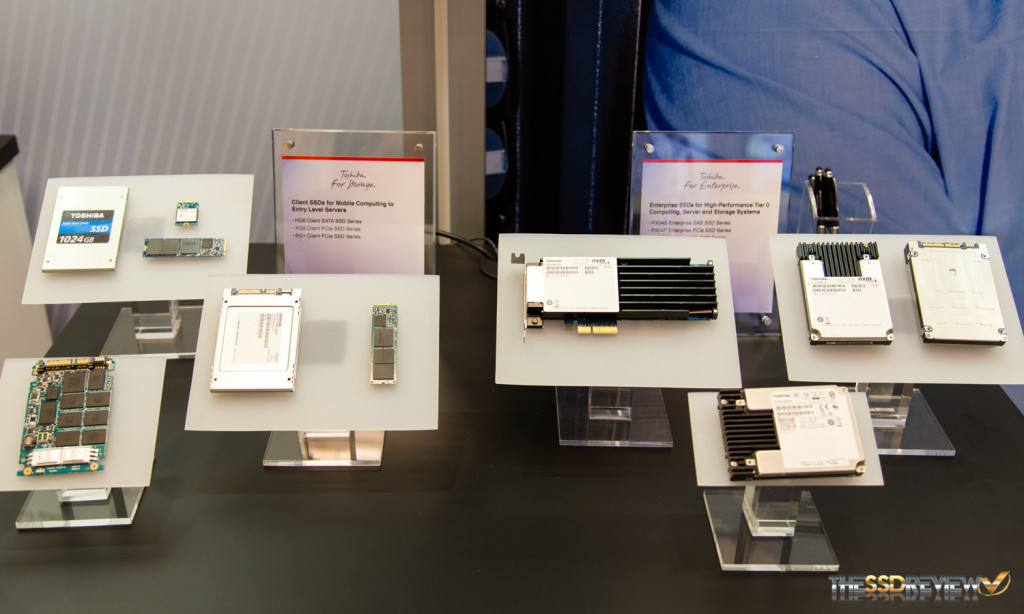Toshiba’s show room was packed with NVMe goodness and a bit more. To start off, while Toshiba does not target the consumer retail market under their name they do target OEM and enterprise customers with their client and enterprise products. Thus, many consumers end up using their storage devices without even knowing it! Nothing is necessarily new from what we have seen at FMS last year, but their current lineup is very competitive with the rest of the market. On the client side, they have products designed for mobile computing to entry level server usage. On display were the HG6 which is a SATA device, the XG3, a high performance PCIe device, and the BG1 is an even smaller PCIe option for use in small form factor devices where every millimeter of real estate counts.
The HG6 is available in almost any form factor you would ask of, SATA, M.2 double and single sided, 2.5” 9.5mm/7mm, and even mSATA for those who have not yet moved onto M.2. Capacities are available from 60GB-512GB and there are both SED and non-SED options.
The XG3 is the highest performing option available on client side. Utilizing a PCIe 3.0 x4 connection and NVMe, it is capable of 3GB/s reads! It is available in PCIe 3.1 x4 M.2 2280 / 2.5” SATA Express form factors and capacities up to 1TB. From what it seems, this drive is the Toshiba brand variant of the RevoDrive 400.
Finally, we were able to see their tiny BG1 Series SSD. The BG1 is one of the smallest SSDs we have ever seen. It has been designed specifically for thin notebooks, 2-in-1 convertibles and tablets. Capacities are available 128GB and 256GB. It comes in M.2 1620, M.2 2230, and M.2 2280 form factors where the NAND and controller is all contained within a single BGA package. By utilizing NVMe and the PCIe interface this device can deliver speeds of over 700MB/s!
Focusing on the enterprise side of things we see their latest and greatest. Of course there is the HK3, a 2.5” 7mm SATA product that offers capacities up to 960GB and endurance ranging from 1-3 drive writes per day depending on model. This drive is great for read intensive applications/light mixed workloads such as VOD and cloud storage.
If you need a little bit more grunt they also have the PX04S, which is a dual port SAS 12Gb/s product that is available in a 2.5” 15mm form factor with capacities up to 3.84TB and endurance rantings from 1 DWPD up to 25. Speeds are very competitive with reads up to 1.9GB/s and writes up to 1.1GB/s. IOPS are rated for up to 270K/115K read/write.
Last but not least, in their display for enterprise storage we also saw the PX04P, which is the higher performing PCIe, NVMe version of their PX04S. Based on the stats, the PX04P proves to be a very competitive enterprise NVMe device for those looking for high performance with a focus on power consumption. It has the ability to deliver up to 3,100MB/s read and 2,350MB/s write and 660K/185K read/write IOPS at a max power consumption of just 18W! It is available in both 2.5″ and HHHL form factors and capacities ranging from 800GB-3.2TB. Best of all, this drive comes with a 5-year warranty and spec’d endurance figures for varying over provisions starting from a 10 DWPD rating at default.
Besides these products, they even had a wafer of the world’s first 48-layer 256Gb TLC 3D NAND on display. In terms of the highlights for this NAND Toshiba states that this latest NAND’s programming time is twice as fast, has 10x the endurance, and to top it off, it is twice as power efficient. So, it is going to be interesting to see what the end performance will be for customers when products start hitting the market. We’re thinking that paired with better firmware we might start seeing TLC SSDs moving into the mainstream segment under the OCZ brand.
That’s it from the Toshiba booth this year at CES! Stay tuned for more as we wrap up our coverage!
 The SSD Review The Worlds Dedicated SSD Education and Review Resource |
The SSD Review The Worlds Dedicated SSD Education and Review Resource | 


is Toshiba 3D NAND 15nm? where did you see this referenced (I did not see it at CES)
3d is most defenetly not 15nm. that would not make any sense.